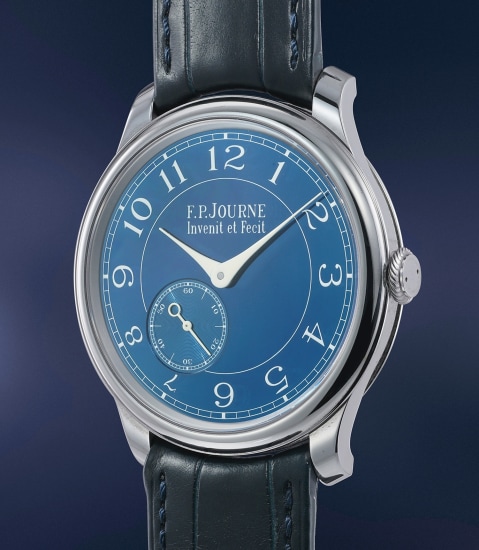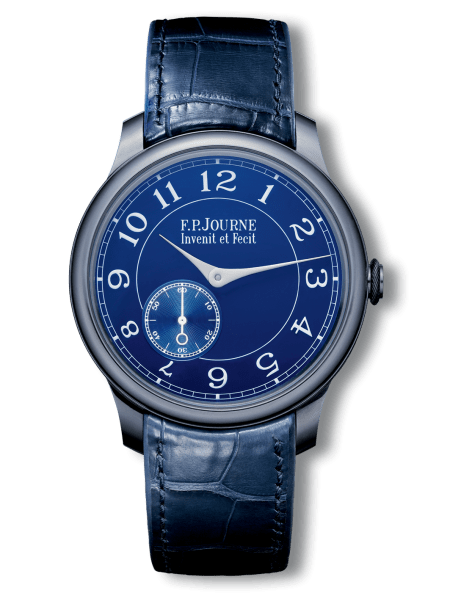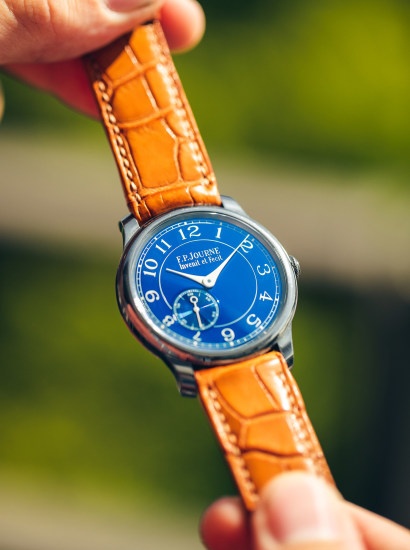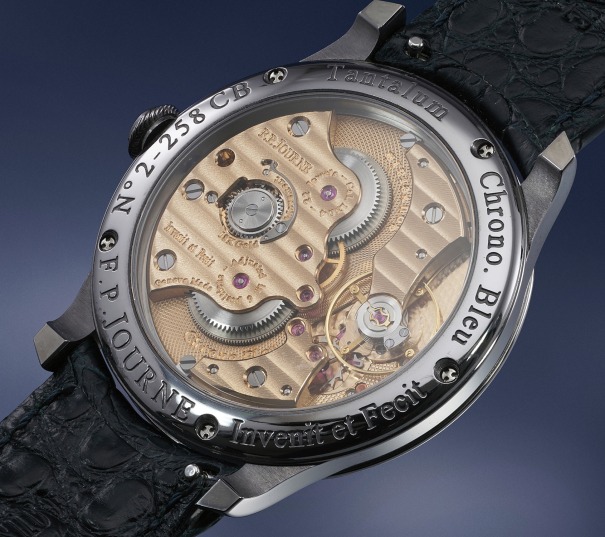This is the F.P. Journe Chronomètre Bleu. Depending on how deep you are into this thing of ours, you may never have heard of this watch. Let alone seen one in the flesh. But amongst certain circles, it has become like gold dust. A rarity on every level. Few luxury watches at any price can rival its beauty, exclusivity, and value. At least that seems to be the popular opinion that has formed now. It wasn’t always the case though. If you can believe it, there was a time, not so long ago that the Chronomètre Bleu was accessible. In the relative sense at least. You still needed a six-figure income or a decent trust fund, but it was possible to buy one at retail. All that’s changed now, of course. So, what makes the Chronomètre Bleu so valuable? Keep reading to find out.
A (Very) Brief History Of The FP Journe Chronomètre Bleu
Launched in 2009, the Chronomètre Bleu built on the success of the Chronomètre Souverain. The earlier (2005) CS collection has more of a traditional bent to it though. Whereas this new model was very much targeted towards younger collectors. An entry-level piece into the brand if you will. A way for the next generation of enthusiasts to discover and enjoy Journe’s creations.
Or at least that was the intention, anyway. But we’ll come to pricing and availability in due course.
- The “entry-level” F.P. Journe Chronomètre Bleu – Image Credit: Phillips.
Don’t assume though that Journe cut corners in making this model more accessible. It’s quite the opposite in fact. The Chronomètre Bleu is one of the most over-engineered time only, dress watches ever. End of. Nothing about this piece is ordinary or “standard”. Yet another reason why it’s become a grail watch for so many collectors.
A Slow Burn
It wasn’t an instant hit though. When this model launched, F.P. Journe was not the mainstream success it is today. Back then the brand – and the man – was only known to especially dedicated connoisseurs. And to be honest, they weren’t sure about the Chronomètre Bleu at first. Journe was (and still is) one of the greatest watchmakers of his era. Renowned for his mastery of a complex and vast array of skills. And for creating some of the most complicated pieces in modern history. Why was he making a simple, time only watch?
The obvious answer is that it was a business decision. And over the years, Mr. Journe has shown himself to be a very savvy businessman as well as watchmaker. He recognised that to grow awareness of his brand he needed a killer, entry-level piece. But it was also very much about challenging himself.
- No room for superflous details here!
You see, the thing with simple watches is that there’s no room for superfluous details. Collectors will accept drawbacks – i.e busy dial, thicker case – if they are necessary to accommodate complications. Look at the Patek Philippe Ref 5070. Simple watches though are all about purity. Every component. Every element. Every design detail. The watchmaker must give them all painstaking consideration. And to Journe’s credit, he gave the Chronomètre Bleu as much time and attention as he did all his other creations. And so, it didn’t take him long to win over the early followers of the brand. The piece was cool, practical and wearable. But it was also very Journe.
The FP Journe Chronomètre Bleu
The Chronomètre Bleu combines Journe’s characteristic style, innovation, and singular vision. It’s wearable on a daily basis. COSC-level accurate. And, up until a few years ago, was obtainable by mere mortals. So, what makes this individual model so special? Let’s get into the details.
The Case
At 39mm x 8.6mm thick, the size and shape of the Chronomètre Bleu case is somewhat traditional. The watch sits very flat against the wrist and is lauded for its comfort and versatility. Less orthodox is the material selected by Journe for the case. Tantalum is among the rarest stable metals on the planet. It’s also very hard and has a high resistance to corrosion and wear. To the untrained enthusiast, tantalum’s heft is indistinguishable from platinum. Yet it is far more challenging to work with and finish. Plus, the scarcity of tantalum watch options makes platinum seem common by comparison.
- The “black chrome” case is something else! – Image Credit: WatchBox
Despite these apparent benefits, you don’t see Tantalum used in watchmaking too often. And there’s a good reason for that. Most manufacturers – including 3rd-party suppliers – don’t work with it. Its very high fusion temperature of 3000° and its density of 16.3 make it a nightmare to manipulate. Which means it’s not exactly compelling as a commercial proposition. And that’s assuming they even have the required expertise.
Of course, as a vertically-integrated manufacture F.P. Journe is not at the mercy of 3rd parties. Instead the company has the technical resources to craft tantalum cases at will. But what really sets the tantalum case of the Chronomètre Bleu apart is its finish. Journe opted for the more challenging polished rather than matte finish. The result is a stunning luster best described as “black chrome.” Although in the right light it also has a bit of blueish tinge to it.
The Dial
The most obvious visual drawcard of the Chronomètre Bleu is its metallic blue dial. One second it appears iridescent, the next a flat navy color, all depending on how the light hits. Today, blue dials are everywhere to the point of becoming commonplace. But this was not the case when the Chronomètre Bleu launched in 2009. Especially not ones with such a vibrant hue. And in fact, some credit this model with initiating the trend. Or at least playing a part.
Of course, the use of the color blue is not new in watchmaking. Rather it has deeply-rooted ties to high horology. In days old it was a signature of royalty and a mark of distinction in fine watchmaking. Blue hairsprings, blue screws, blue hands, blue enamel. All hallmarks of the beloved of historic masters and watchmakers-to-kings. Think A.L. Breguet, Pierre Jaquet-Droz, and Nicolas Mathieu Rieussec.
But the visage of the Chronomètre Bleu is no anachronism.
- A stunning shot of that chrome blue dial catching the light just right – Image Credit: Phillips.
This is a very contemporary dial executed using modern techniques. Yet, as with the dial color, the details also pay subtle homage to the past. For example, Journe’s treatment of the pocket watch style subsidiary seconds dial. The concentric circular guilloché and a miniature “railroad” seconds track recall his origins as a specialist in vintage restoration. But the calculated asymmetry of the off-center subdial is a nod to postmodern caprice and irony.
Around the periphery, Arabic numerals in ornate heritage font combine with a “sector” minute track. Another subtle nod to tradition. But then Journe renders the printed marks in a droll off-white verging on cream. Unique tapered hands in a matching tone complete the retro-modernist fusion. And so, even though the dial of the Chronomètre Bleu appears simple, there is a lot going on. If you know where to look.
The Movement
Where the complexity and attention to detail of this piece becomes apparent is on the back. Having built his first tourbillon while still in his 20s, F.P. Journe doesn’t settle for a pretty face. The name, of course, hints at the horological virtues of the Chronomètre Bleu. But they only reveal themselves through the sapphire caseback.
Journe’s in-house caliber 1304 is hewn entirely in 18-karat rose gold. Not a gilt coating but a solid gold mass of 18k plates and bridges. Each bridge bears linear côtes de Genève. Every screw is polished, immaculately slotted, and chamfered around its circumference.
- The 18k solid gold movement is the stuff of legend! – Image Credit: Phillips.
Journe’s mission was to create a chronometer-grade movement as beautiful as it is precise. In line with this, the going train that links the balance to the spring barrels runs under the dial. As opposed to taking the conventional path across the caseback. This ensures uninterrupted views of the cal. 1304’s contrasting barleycorn and tight perlage finish. The lack of visible train wheels also mean the balance cock and escapement appear to move as if by magic.
The critical balance assembly is free sprung for maximum resistance to shock-induced variation. A massive balance wheel packs an exceptional 10.10 mg/cm2 moment of inertia. Making it resistant to all but major knocks. Journe laser-welds the hairspring to the collet to avoid accidental displacement. No detail has been overlooked in the quest for accuracy.
Twin mainspring barrels operate in parallel, promoting a steady release of force. Even by today’s standards the 56-hour power reserve is respectable. Yet Journe’s goal was always absolute consistency. As such, the Chronomètre Bleu remains one the rare haute horlogerie timepieces to seek and receive COSC Swiss Chronometer certification.
Pricing & Availability Of The Chronomètre Bleu
Today, the Chronomètre Bleu is one of the most sought-after time only models on the market. From any brand. It is right up there with the likes of PP’s Ref 5711 and AP’s Ref 15202ST. Which is saying something when you consider the latter are two of the most iconic models on the planet. Your chances of finding one at retail are rare. So rare in fact that collectors joke that the case metal is now hewn from unobtanium. Rumour has it that after the wait list ballooned out to 8 years, they stopped taking names.
As such, like most steel Rolex models, the retail price has become irrelevant. Unless you have serious buying history with Journe direct. (Or one of its handful authorized retailers.) Otherwise, your only option is the secondary market. At the time of writing, prices for the Chronomètre Bleu are sitting at around US$90,000 – US$100,000. And seem to be holding firm for now.
Availability remains the key issue though. Journe has no interest in increasing production of the Chronomètre Bleu to meet current demand. If anything, production volumes have gone the other way. In fact, a few collectors I’ve spoken to have the formed the opinion this watch is, in effect, discontinued. Even though there’s been no formal announcement from the brand.
Is The Hype Real?
The popularity of F.P. Journe watches has come a long way since the Chronomètre Bleu made its debut. It’s sky-rocketed in fact. Today, most models have long waiting lists and command huge premiums on the secondary market. There’s no doubt the genius of Journe is worthy of this rabid adulation. That said, it still seems disproportionate to the market as a whole. Not to mention the performance of other independent watchmakers. Not that many – if any – are directly comparable to Journe.
But there’s more at play here.
A few years back, some of the larger players in the secondary market took a special interest in Journe. As they hoovered up and stockpiled available stock, demand began to grow. Couple that with an insane run in the red-hot auction market over the past few years. All of which meant prices came along for the ride. Today’s market is a reflection of the culmination of this. Which is why some collectors don’t believe the hype is real. Rather it’s the result of a manipulated market. Whether there’s any truth to that we might never know for sure. The fact is, prices are where they are.
That doesn’t make collectors love the Chronomètre Bleu any less mind you. But at four times retail, it definitely requires a strong constitution. Although some suggest it’s starting look like it’s hit a ceiling. Whether prices will come back down to more acceptable levels is another question. One thing is for sure; Journe won’t be increasing production anytime soon. So, if you want a Chronomètre Bleu at retail, you might be waiting a good long while. Assuming you ever get the chance at all.
Technical Specifications: F.P. Journe Chronomètre Bleu
- Case: 39 mm x 8.6mm – Tantalum – see-through caseback – scratch resistant sapphire crystal on both side – waterproof to 50 metres.
- Dial: Chrome blue – hands in ivory colored steel – Arabic numerals – running seconds on sub-dial.
- Movement: Calibre 1304 – in-house – manual-winding – 56-hour power reserve – movement in 18k rose gold.
- Price: USD90,000 – USD100,000 on the secondary market.





Question….which one is a better investment, the chronometre bleu or the chronometre bleu mother of pearl, boutique edition??
This will be my first Journe piece, I am a female and trying to decide between these two.
Thank you!